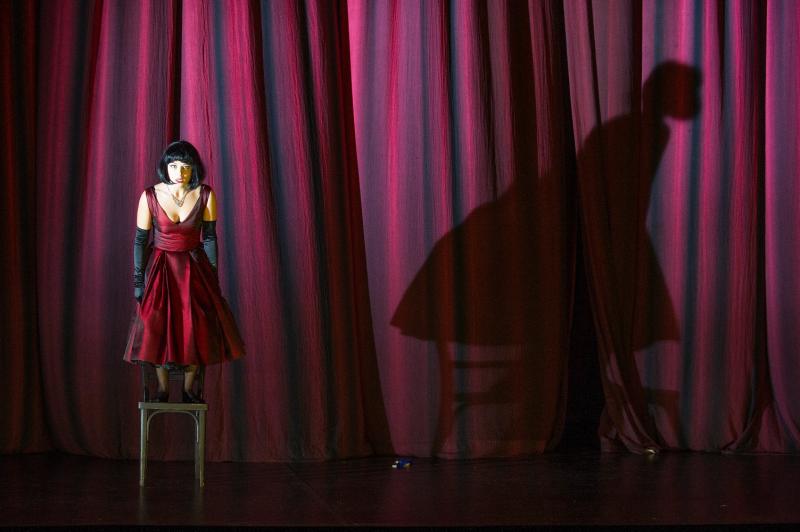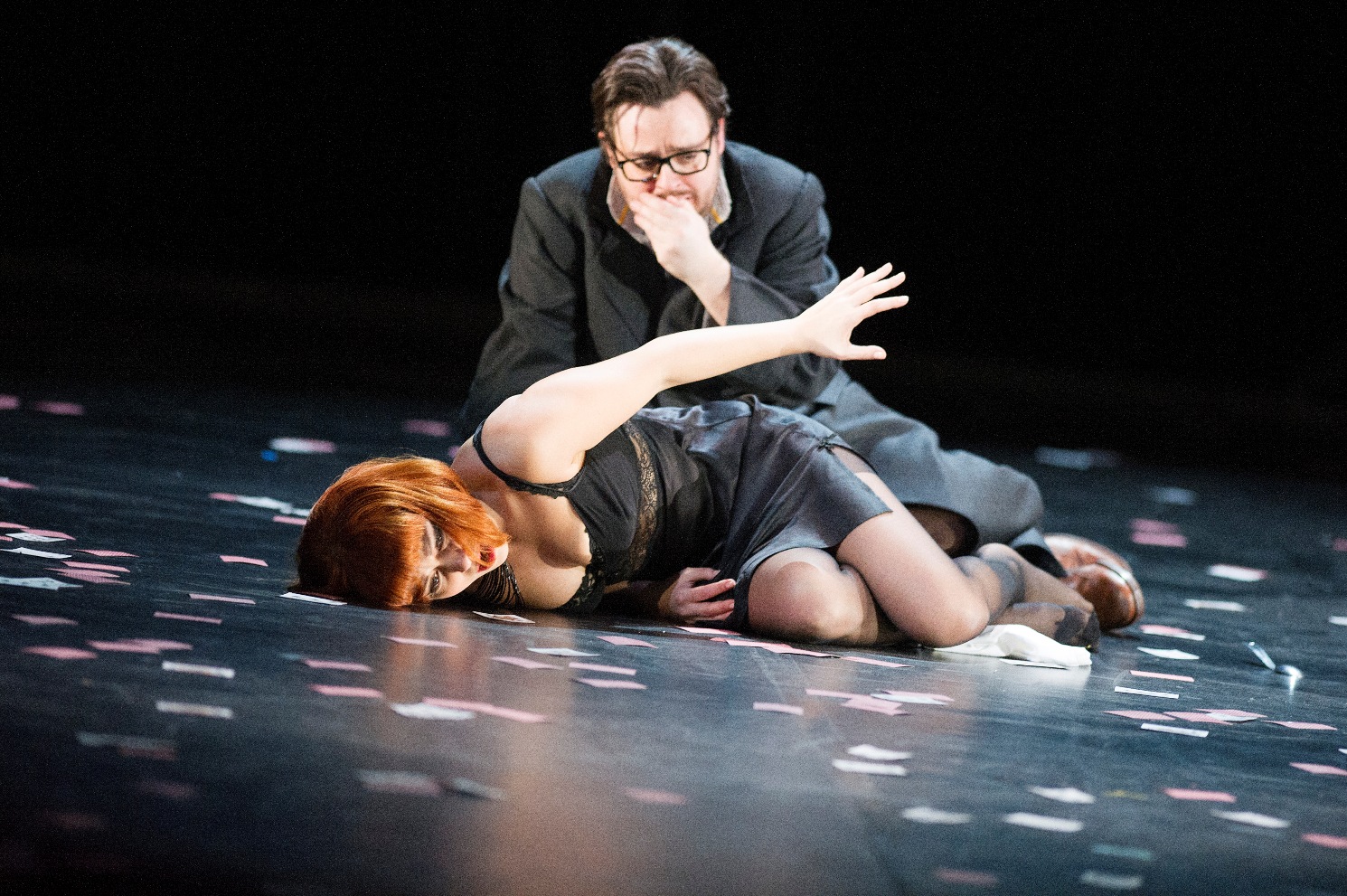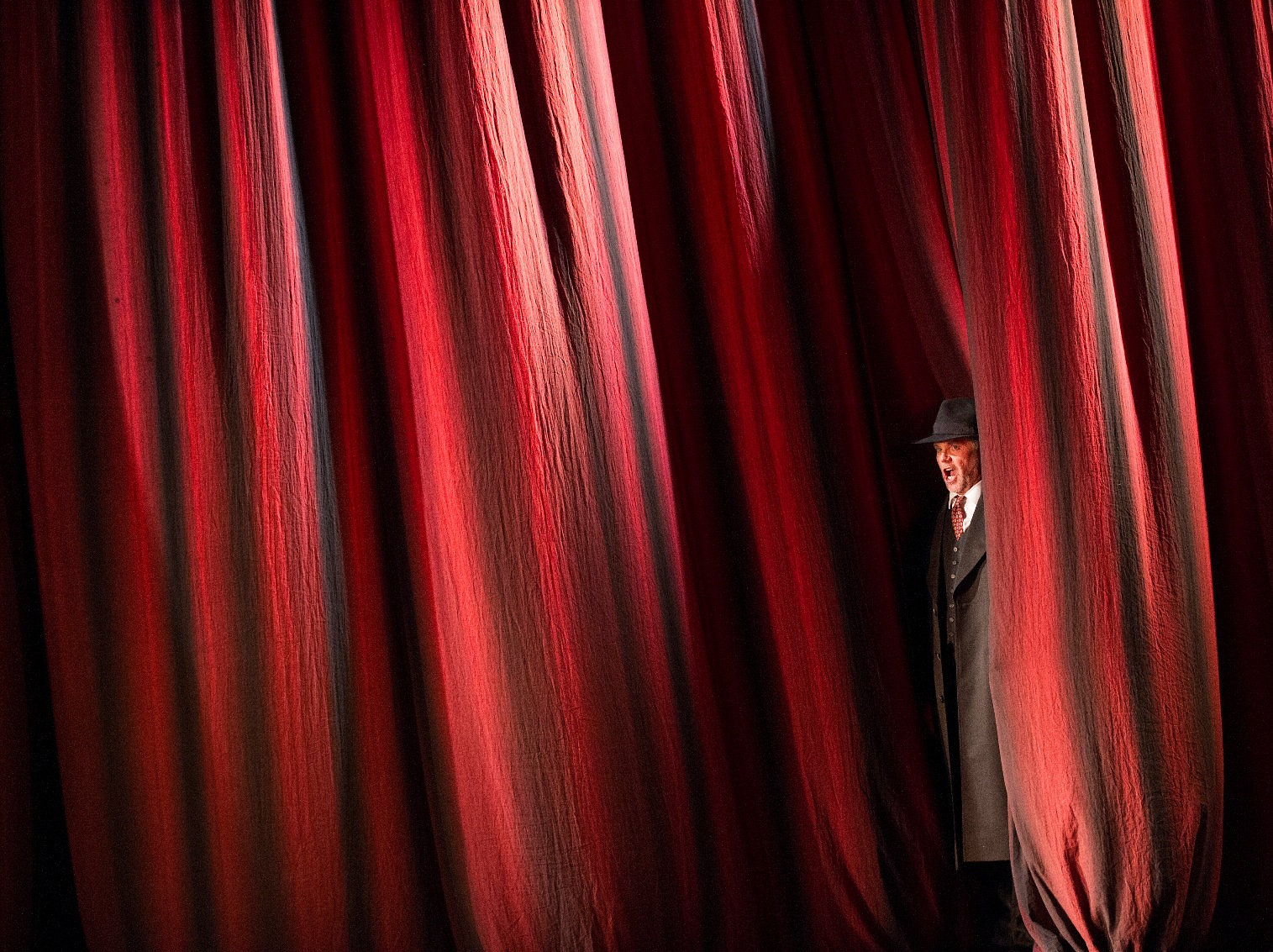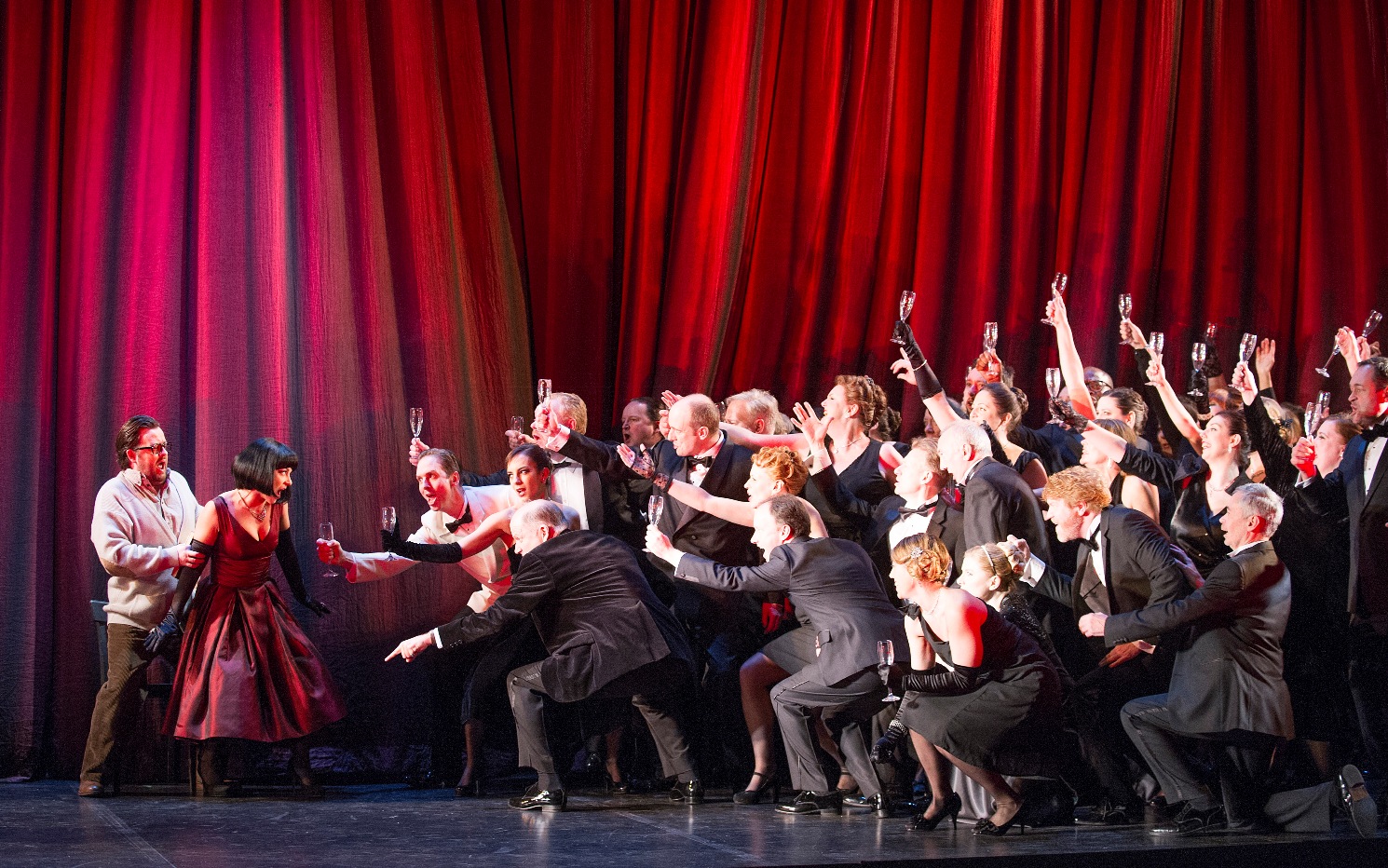La Traviata, English National Opera | reviews, news & interviews
La Traviata, English National Opera
La Traviata, English National Opera
A heartfelt Violetta can't hope to connect with her men in awkward update

How’s a good time girl to bare her beautiful soul when a director seems bent on cutting her down to puppet size? It doesn't bother me that Peter Konwitschny shears Verdi’s already concise score by about 20 minutes to shoehorn it into a one-act drama; what goes is either inessential or among the usual casualties of standard Traviatas. The spare and economical idea of layered curtains to symbolise the characters' constriction or emancipation is good in principle, too.
There’s not much vocal shapeliness about conductor Michael Hofstetter’s chilly account of the Prelude (apart from a few surprising blaze-ups, the rest is efficient rather than ideally fluent). And we soon realise there’s distancing in Konwitschny’s initial concept: Violetta the seemingly brittle society victim gets pushed together with bookish Alfredo, a duffle-coated nerd catapulted among the DJs and silks. She can change; he can’t, according to Konwitschny. Country love and a dying Violetta leave him as stiff and awkward as ever. There’s no real ardour, no real anger or regrets for poor Ben Johnson (pictured with Winters in the final scene below) to latch on to. Still, this young British tenor is a real asset for ENO – probably more for Mozart and Britten than Verdi or Puccini, for even this lightish role is a bit of a stretch at the top for him.
 Konwitschny thinks we’re more likely to believe in Violetta’s sacrifice for Alfredo’s convention-bound father if the daughter she’s supposed to step aside for is shoved on to the stage as a harrowed, pigtailed schoolgirl: the courtesan might do her best for another downtrodden female. This, though, makes father Germont so much the irredeemable bully that the shifting dynamics of the great duet at the heart of the opera go for nothing (and what’s with the gun Violetta pulls towards the end?) Anthony Michaels-Moore (pictured below), after an unsettled start on the first night which found him hectoring the smoother legato lines, is the genuine Verdi-baritone article, and sings his romance of attempted consolation to the devastated Alfredo with real style. But his character remains as one-dimensional as his son’s.
Konwitschny thinks we’re more likely to believe in Violetta’s sacrifice for Alfredo’s convention-bound father if the daughter she’s supposed to step aside for is shoved on to the stage as a harrowed, pigtailed schoolgirl: the courtesan might do her best for another downtrodden female. This, though, makes father Germont so much the irredeemable bully that the shifting dynamics of the great duet at the heart of the opera go for nothing (and what’s with the gun Violetta pulls towards the end?) Anthony Michaels-Moore (pictured below), after an unsettled start on the first night which found him hectoring the smoother legato lines, is the genuine Verdi-baritone article, and sings his romance of attempted consolation to the devastated Alfredo with real style. But his character remains as one-dimensional as his son’s.
 For Corinne Winters, there are the same obstacles to creating a real human being. In an uneasy balance between stylisation and naturalism, every move seems phoney: drag the curtains here, jump off the chair and collapse there. Which is a terrible shame because, although hers may not be the most individual of voices, she fills it with intensity and can do everything Verdi asks: the coloratura hectic flushes of the determination to carry on with the high life at the end of the first scene, the lirico spinto ability to pull out the vocal stops for the big, desperate phrase of “Love me, Alfredo” and the curving lines of anguish in the second party scene, the tenderness of the too-late last love duet.
For Corinne Winters, there are the same obstacles to creating a real human being. In an uneasy balance between stylisation and naturalism, every move seems phoney: drag the curtains here, jump off the chair and collapse there. Which is a terrible shame because, although hers may not be the most individual of voices, she fills it with intensity and can do everything Verdi asks: the coloratura hectic flushes of the determination to carry on with the high life at the end of the first scene, the lirico spinto ability to pull out the vocal stops for the big, desperate phrase of “Love me, Alfredo” and the curving lines of anguish in the second party scene, the tenderness of the too-late last love duet.
That final scene ushers in another problem for Winters, though. The red curtains of Johannes Leiacker’s effective designs work well; it’s certainly a bold moment in Konwitschny’s “Scene Three” when, in a fast moving party scene thankfully free of rhe usual gypsies and toreadors, Alfredo’s violence in the big confrontation sees all the red drapes pulled down, the chorus crashing to the ground only to crawl off and leave the heroine to her endgame. That leaves a black curtain at the very back of the stage against which Violetta has to deliver the aria we know as “Addio del passato”.
 It’s a measure of Winters’s emotional projection that we can still hear her with her back to the audience and as far away from them as the all too vast Coliseum stage allows. And why can’t Alfredo and Violetta just hold each other for their simple dreams of an illusory future instead of stepping back again to try in vain to pull some invisible curtains back (you get the symbolism very quickly). The intimacy which is so strong a feature of Verdi's semi-domestic opera seems less valid than ever in this vast venue.
It’s a measure of Winters’s emotional projection that we can still hear her with her back to the audience and as far away from them as the all too vast Coliseum stage allows. And why can’t Alfredo and Violetta just hold each other for their simple dreams of an illusory future instead of stepping back again to try in vain to pull some invisible curtains back (you get the symbolism very quickly). The intimacy which is so strong a feature of Verdi's semi-domestic opera seems less valid than ever in this vast venue.
The last image, at least, is strong: the Germonts and hapless Doctor Grenvil singing from the auditorium, Violetta reaching out from the stage before stepping out of the circle of light and into the blackness beyond. But after a too-solid Mimì (Maija Kovalevska) in a Covent Garden Bohème which is as conventional as the Traviata there – time for a change – here was a second consumptive heroine who couldn’t make us shed a tear. And this time we had a soprano who was perfectly capable of doing so in the right circumstances. If you want to see a German regietheater re-think which works, watch the DVD of Willy Decker’s Salzburg production with Anna Netrebko and Rolando Villazón. Although none of the smaller roles made much impact at ENO, the company should be proud of fielding a pair of lovers not too far behind that starry couple; it’s just a shame that Winters and Johnson have a director who works against them.
rating
Share this article
Add comment
The future of Arts Journalism
You can stop theartsdesk.com closing!
We urgently need financing to survive. Our fundraising drive has thus far raised £33,000 but we need to reach £100,000 or we will be forced to close. Please contribute here: https://gofund.me/c3f6033d
And if you can forward this information to anyone who might assist, we’d be grateful.

Subscribe to theartsdesk.com
Thank you for continuing to read our work on theartsdesk.com. For unlimited access to every article in its entirety, including our archive of more than 15,000 pieces, we're asking for £5 per month or £40 per year. We feel it's a very good deal, and hope you do too.
To take a subscription now simply click here.
And if you're looking for that extra gift for a friend or family member, why not treat them to a theartsdesk.com gift subscription?
more Opera
 Help to give theartsdesk a future!
Support our GoFundMe appeal
Help to give theartsdesk a future!
Support our GoFundMe appeal
 Owen Wingrave, RNCM, Manchester review - battle of a pacifist
Orpha Phelan brings on the big guns for Britten’s charge against war
Owen Wingrave, RNCM, Manchester review - battle of a pacifist
Orpha Phelan brings on the big guns for Britten’s charge against war
 Tales of Apollo and Hercules, London Handel Festival review - compelling elements, but a failed experiment
Conceptually the two cantatas just don't work together
Tales of Apollo and Hercules, London Handel Festival review - compelling elements, but a failed experiment
Conceptually the two cantatas just don't work together
 La finta giardiniera, The Mozartists, Cadogan Hall review - blooms in the wild garden
Mozart's rambling early opera can still smell sweet
La finta giardiniera, The Mozartists, Cadogan Hall review - blooms in the wild garden
Mozart's rambling early opera can still smell sweet
 Der fliegende Holländer, Irish National Opera review - sailing to nowhere
Plenty of strong singing and playing, but the staging is static or inept
Der fliegende Holländer, Irish National Opera review - sailing to nowhere
Plenty of strong singing and playing, but the staging is static or inept
 Die Zauberflöte, Royal Academy of Music review - first-rate youth makes for a moving experience
The production takes time to match Mozart's depths, but gets there halfway through
Die Zauberflöte, Royal Academy of Music review - first-rate youth makes for a moving experience
The production takes time to match Mozart's depths, but gets there halfway through
 Mansfield Park, Guildhall School review - fun when frothy, chugging in romantic entanglements
Jonathan Dove’s strip-cartoon Jane Austen works well as a showcase for students
Mansfield Park, Guildhall School review - fun when frothy, chugging in romantic entanglements
Jonathan Dove’s strip-cartoon Jane Austen works well as a showcase for students
 Uprising, Glyndebourne review - didactic community opera superbly performed
Jonathan Dove and April De Angelis go for the obvious, but this is still a rewarding project
Uprising, Glyndebourne review - didactic community opera superbly performed
Jonathan Dove and April De Angelis go for the obvious, but this is still a rewarding project
 Fledermaus, Irish National Opera review - sex, please, we're Viennese/American/Russian/Irish
Vivacious company makes the party buzz, does what it can around it
Fledermaus, Irish National Opera review - sex, please, we're Viennese/American/Russian/Irish
Vivacious company makes the party buzz, does what it can around it
 The Capulets and the Montagues, English Touring Opera review - the wise guys are singing like canaries
There's a bel canto feast when Bellini joins the Mob
The Capulets and the Montagues, English Touring Opera review - the wise guys are singing like canaries
There's a bel canto feast when Bellini joins the Mob
 Mary, Queen of Scots, English National Opera review - heroic effort for an overcooked history lesson
Heidi Stober delivers as beleaguered regent, but Thea Musgrave's opera is limiting
Mary, Queen of Scots, English National Opera review - heroic effort for an overcooked history lesson
Heidi Stober delivers as beleaguered regent, but Thea Musgrave's opera is limiting
 Festen, Royal Opera review - firing on every front
No slack in Mark-Anthony Turnage's operatic treatment of the visceral first Dogme film
Festen, Royal Opera review - firing on every front
No slack in Mark-Anthony Turnage's operatic treatment of the visceral first Dogme film

Comments
The new ENO La Traviata in
I couldn't agree more with
I can only concur with the
I urge readers of Mr Nice's
I'd be interested to know
I'd be interested to know what you think the "wood" might be. I saw only one living tree in Konwitschny's concept, the Violetta, and he admits it - the rest are dead wood. Not helpful to the drama. Rupert Christiansen in the Telegraph sums it up nicely, I think: "although Konwitschny’s vision is sharp-edged and clean-lined, it seems bleak, narrow and jejune compared to Verdi’s".
Like him, I found the evening "gripping and impressive" but not "moving or beautiful". But Mr Rosenthal misinterprets me in his account of the applause: I was brava-ing as loudly as anyone for Corinne Winters. And I think I make it clear that this is still a performance well worth going to see.
I was there on first night
I agree with all those who
I agree with all the above!
For what it's worth, I saw
The music and the singing